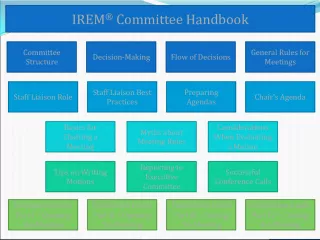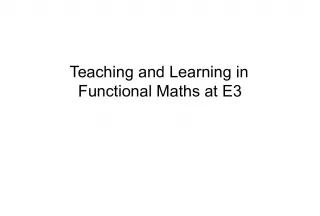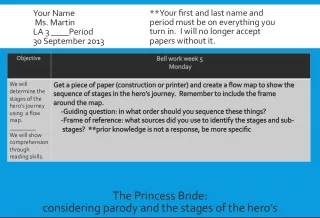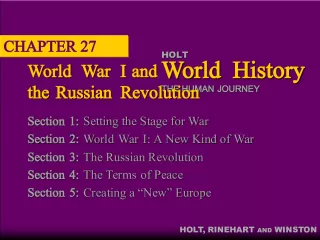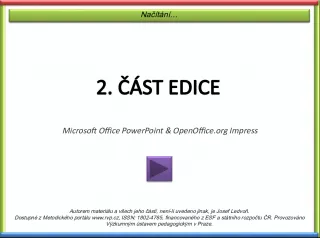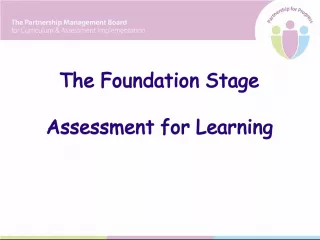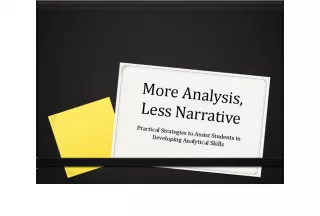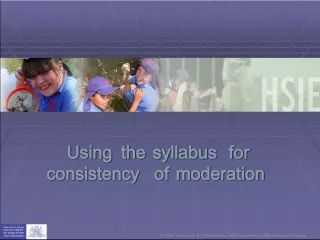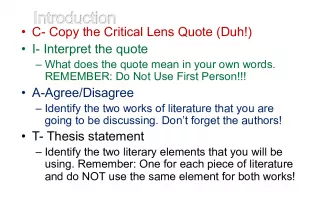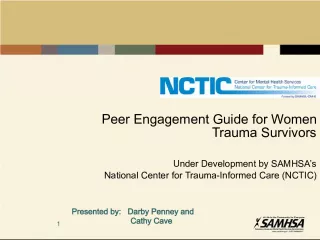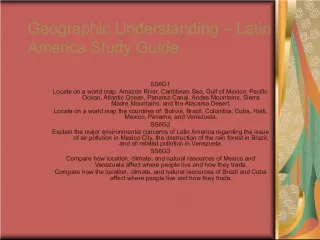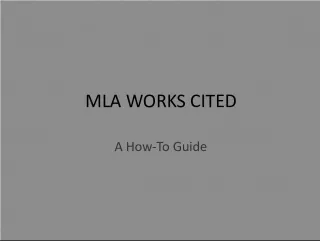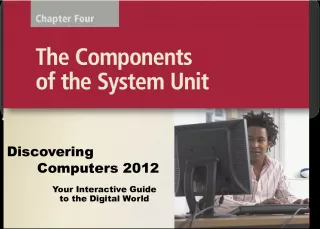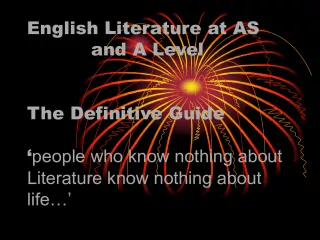A Practical Guide to Stage Directing
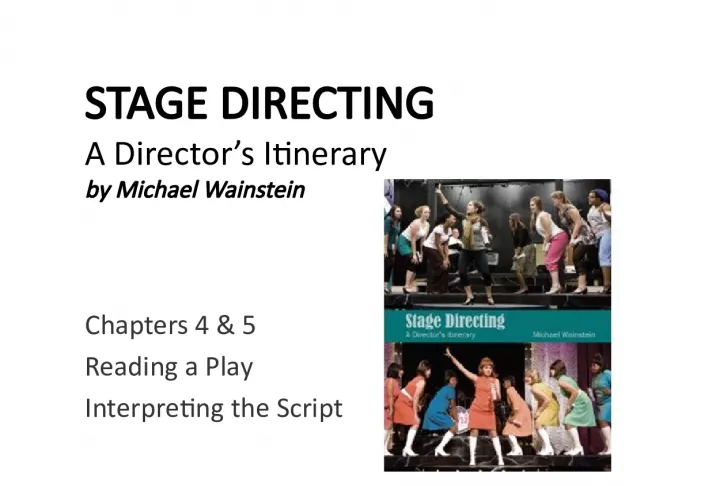

This guide by Michael Wainstein provides practical insights into stage directing. Chapters 4 and 5 cover reading a play and interpreting the script, respectively. The first read is emphasized as crucial to a director's work.
- Uploaded on | 9 Views
-
 cason
cason
About A Practical Guide to Stage Directing
PowerPoint presentation about 'A Practical Guide to Stage Directing'. This presentation describes the topic on This guide by Michael Wainstein provides practical insights into stage directing. Chapters 4 and 5 cover reading a play and interpreting the script, respectively. The first read is emphasized as crucial to a director's work.. The key topics included in this slideshow are stage directing, script interpretation, reading a play, director's itinerary, first read,. Download this presentation absolutely free.
Presentation Transcript
1. STAGE DIRECTING A Directors Itinerary by Michael Wainstein Chapters 4 & 5 Reading a Play Interpreting the Script
2. READING THE SCRIPT Chapter Four
3. First Reading Read for pleasure. The first read allows for the directors personal reaction that is the seed from which all further work grows.
4. First Reading Make notes about what you read.
5. Ask these questions 1. What did you feel when you put the play down after reading? 2. What did you love about the play? 3. What did you dislike 4. What did it make you think about? 5. Was it entertaining? Thought provoking? Emotionally charged?
6. Ask these questions 6. What characters could you relate with? 7. What are the obvious themes of the play? 8. What did you relate to personally? 9. Why do you think the author wrote the play? 10. Anything else?
7. Second Reading Read for vision The ability to think about or plan the future with imagination or wisdom. Develop a concept Record new ideas
8. Third Reading Read for analysis. This reading is slow and detailed.
9. Third Reading As you read, you need to jot down information as it is revealedword by word, line by line, page by page
10. Final thoughts on reading a play Reading the play repeatedly is important because it allows the director to discover nuance and detail. Each type of reading yields its own particular benefit Remaining faithful to the play is the directors responsibility.
11. Primacy of the script Remember that you are interpreting a work, not creating your own
12. INTERPRETING THE SCRIPT Chapter Five
13. The Importance of Analysis ARISTOTLE was the first to define the structure of drama
14. The Six Elements ARISTOTLE observed six elements necessary to interpret the play: plot, character, ideas, language, music and spectacle. These observations from his POETICS have been the basis of play analysis for over 2300 years.
15. Aristotles definition of tragedy A tragedy, then, is the imitation of an action that is serious and also, as having magnitude, complete in itself; in language with pleasurable accessories, each kind brought in separately in the parts of the work; in a dramatic, not in a narrative form; with incidents arousing pity and fear, wherewith to accomplish its catharsis of such emotions. (Imgram Bywater: 35). Tragedy, then, is an imitation of an action of high importance, complete and of some amplitude; in language enhanced by distinct and varying beauties; acted not narrated; by means of pity and fear effectuating its purgation of these emotions. (L. J. Potts: 24).
16. Aristotles definition of tragedy Tragedy, then, is an imitation (mimesis) of an action that is serious, complete, and of a certain magnitude; in language embellished with each kind of artistic ornament, the several kinds being found in separate parts of the play; in the form of action, not of narrative; through pity (eleos) and fear (phobos) effecting the proper purgation (catharsis) of these emotions. (S.H. Butcher, The Poetics , Part VI).
17. How to remember the six elements The play is about people (character) in a situation (plot) who communicate with one another (dialogue) about something (ideas), in a certain way (music/rhythm) somewhere in time and space (spectacle).
18. A heirarchy Sophocles identified the six elements in a particular sequence noting that ACTION (plot) is the most important element, followed by CHARACTER (agents of the plot), THEME (idea), LANGUAGE (rhetoric), RHYTHM (harmony and music) and finally, SPECTACLE (what is seen).
19. Dramatic Action The audience wants to see the characters fight adversity, learn grow as human beings and either succeed in the case of comedy, or fail in the case of tragedy.
20. The DPN (Directors Production Notebook)
21. Spectacle Genre Plays are grouped together according to style, theme and subject matter. Knowing the genre of the play allows the director to situate it within certain expectations.
22. Spectacle Given circumstances
23. Given Circumstances Worksheet Time. When is the play written? When is it set? How much time passes? Place. Where is the play set? How does environment affect the action? Society. What social groups are the norm? What are sexual, class, gender, family relationships? What role does family play in this world? Economics. How does money figure into the world of the play? What control does it have over the characters? Culture. What trends in art, theatre and literature are implicity or explicity revealed in the play? Does this affect the characters? Spirituality. Identify the religious or spiritual aspects of the play and how the affect the characters or impact the story.
24. Character Identify and define the characters Protagonist is the main character who drives the plot Antagonist opposes the main action and creates the central conflict of the play What roles do the other characters play?
25. Character Given circumstances include age, language and time period; social status, family history and might include a brief physical description. What is the essential action of the character. What does he or she want?
26. Character Qualities might describe the tactics the character uses to pursue his or her goals. Conflict and relationships describe how the various characters relate to one another. What can they get from one another? What can they take? Who can help them? Who can hurt them?
27. Other qualities of character (cont.) Willpower is the amount of intensity employed to pursue a goal. Values describe how a character views what is good or bad; what characters stand for or against. Personality is how the characters appear to others and demonstrated by their actions. Complexity suggests how aware characters are of their situation.
28. Objectives and superobjectives From the Stanislavsky system Characters want to accomplish goals or objectives A characters super-objective is the need that governs all needs. What is needed to resolve the characters central conflict?
29. Hodge approach From Hodge and McLains PLAY DIRECTING: Analysis, Communication & Style , 6 th edition Character is ACTION Characters are SIMPLE or COMPLEX Character is revealed in ACTION A METHOD OF CHARACTER DESCRIPTION DESIRE. What the character wants most. WILL. The characters relative strength in attaining his or her goals. MORAL STANCE. How honest is he with other and with himself? What is his or her sense of integrity? Is this an evil or good character? DECORUM. What a character looks like manners poise. The projection of an outward appearance. (Can be altered by casting.) SUMMARY ADJECTIVES. What character traits does the action reveal? CHARACTER-MOOD-INTENSITY. The physical or body-state of the character (nervosity) at the beginning of the play and the beginning of each group of associated units.
30. Patterson approach Personality traits Action traits Functional traits Superobjective
31. PLOT A collection of action points from beginning to end. These allow the director to chart the progress of the plot in a detailed way. A common system of identifying such units is to describe French scenes.
32. ACTION External action is the blocking, movement and location of characters on the stage Internal action is what happens in the characters mental, spiritual and emotional life.
33. An example from HAMLET (I:v) CHARACTERS present Hamlet The Ghost EXTERNAL action Hamlet speaks with the ghost INTERNAL action Hamlet resolves to avenge his fathers death
34. Backstory or Exposition Create a list of all story points and describe each units essential action . - What is revealed in the scene? - Who reveals it? To whom? - How is it revealed? - Is the information true or false? - How does it impact the plot or characters?
35. Structure of dramatic action Inciting action is the event the sparks the action of the playwhere the major conflict comes alive Climax is where the conflict reaches its highest intensity Falling action is the moment the conflict is resolved
36. Conflicts and obstacles This clash is between two characters In HAMLET, for example it is a conflict between Hamlet and Claudius Notably, the conflict in the action is not between Hamlet and God, although that is a thematic element An obstacle is what gets in the way of the protagonist in his or her pursuit of the super-objective
37. IDEAS or theme What does the title tell us about the play? What major ideas are discussed in the dialogue ? Aphorisms (a concise statement of thruth) Allusions (references to other places of things) Imagery (metaphor, simile, figurative language) Symbolism Themes are ideas that recur or pervade a work of art
38. RHYTHM Beats Acts Scenes Major beats (units) Minor beats or bits Atmosphere pace and tempo (speed or rate) rhythm (a pattern of tempos) atmosphere (mood)
39. DIALOGUE STYLES OF DIALOGUE Realistic Abstract Naturalistic Formal or informal Colloquial Dialect
40. Diction and Grammar Characters are shaped by the way they speak. How does language distinguish characters?
41. SUBTEXT Because a play is not readily afforded the luxury of third person narration like a novel, what a character is really thinking is often not explicitly stated. Great playwrights, like Chekhov, are masters of subtext.
42. What does subtext tell us? What thoughts are true? What is spoken out loud? What is shown but not said? What is being concealed?
43. Final thoughts Once the director has completed the analysis, it is important to return to the play as a unified, coherent whole. Formulating the main idea of the play is part of this reassembling of elements.
44. Formulate the main idea Creative a subjective statement that expresses, in a short sentence, what the play is aboutthe director can use this main idea to communicate to the artistic team and the actors what the director wants the production to say. Hamlet is a 1948 British film adapted, directed by and starring Sir Laurence Olivier . His main idea for the film is simply stated in the films prologue"This is the tragedy of a man who could not make up his mind."
45. Steps to develop the main idea 1. List the prevalent themes. 2. Select a single theme that resonates strongly. 3. Relate the theme to yourself. 4. Write a short, personal statement from your point of view that communicates the plays theme and the writers reasons for writing it. 5. Keep it short, succinct and in cause-and- effect format.
46. RIDERS TO THE SEA is the story of a mother trying to cope with a family tragedy despite the good intentions of others around her.
47. Testing the IDEA From Hodge, PLAY DIRECTING . Arrive at the idea of a play by analyzing the actionthat is by drawing the logical conclusion from the action and the outcome or ending for each principal character. Write a brief statement that captures the character, the essence of her struggle and the outcome. Use the following form The is a play about a _________ who______________.
48. OEDIPUS THE KING is the story of a man who challenges himself to seek truth regardless of the consequences.

